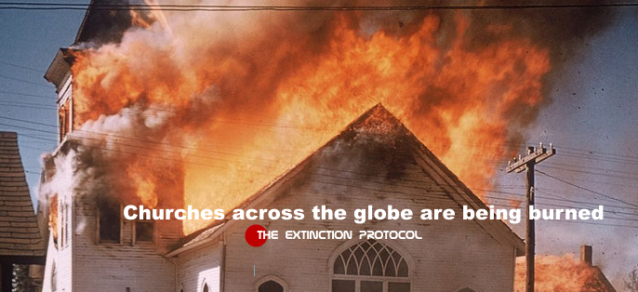Part 2: Violence, pestilence, and natural disasters proliferate: are we approaching the End of Time?

Plagues of locust swarms: As if 2020 hasn’t thrown enough curveballs already, desert locusts are setting off a global panic. From Kenya to Pakistan to, most recently, Yemen, China, Italy, and Argentina, locust swarms have been on the move. The infestation is most advanced in East Africa, which is experiencing the worst locust outbreak in generations. There has been six major locust plagues in the last century, one of which lasted nearly 13 years, according to the U.N. But the current infestation in East Africa is technically an upsurge, as defined by the Food and Agriculture Organization. Depending on locust control efforts and favorable breeding conditions in terms of moisture and soil, the upsurge could spread even further and get upgraded to a plague. –Vice
Global protests and social anarchy: 2019 saw a spate of protests sweep across the globe. From Latin America, to the Middle East, to Europe, a wave of dissatisfaction with the status quo engulfed the developed and developing world alike. The question is whether that will continue in 2020 and if so, what form will it take? Fueling the anger of many, and entrenching divisions between people and power, have been the violent response of many governments to the largely peaceful demonstrations. Police brutality, mass arrests, assault, tear-gas protesters, and even killings have become commonplace. In Latin America, governments have thrown blame on each other, closing borders to neighbors for fear of foreign influence. The new Bolivian government has expelled 725 Cuban nationals, many of whom are doctors and medical staff working there under an agreement with the Morales government.
“This is the new face of inequality,” says Achim Steiner, an Administrator at the UNDP, as he reflected on the protests. The UNDP’s report, released in December, painted a damning portrait of the entrenched levels of inequality that not only persist, but whose roots are becoming more embedded in the face of unchecked global growth. The 2019 Inequality-Adjusted Human Development Index, the sister index of the Human Development Index, revealed that 20 per cent of human development progress was lost through inequalities in 2018. Without action from the top-down, we can expect to see more and more movement from the bottom-up. The coming decade will bring with it even more challenges to the people, as the automation of work risks mass unemployment, and the effects of climate change threaten the displacement of millions. –The Article

The rise in church burnings: The fire that ripped through the Gothic Cathedral of St. Peter and St. Paul in Nantes July 18 was reported around the world. But suspected arson attacks on French churches usually do not make international headlines. Since 2010, the Paris-based L’Observatoire de la Christianophobie (Observatory of Christianophobia) has chronicled anti-Christian incidents in France and around the world. It has recorded these events month by month on interactive maps since 2017, placing them in six categories: arson, murder/assault, vandalism, theft, bombing, and abduction.
Following Saturday’s fire at Nantes, the organization has reported several less well-publicized incidents, including the destruction of a crucifix on the Île-d’Arz in Brittany, the slashing of paintings in a church in Auxerre, and the decapitation of a statue of the Virgin Mary in Montaud. Statistics suggest there are nearly three such attacks a day in France, which is sometimes described as the “eldest daughter of the Church” because the Frankish King Clovis I embraced Catholicism in 496. The French Interior Ministry recorded 996 anti-Christian acts in 2019 — an average of 2.7 per day. The true figure may be higher, as it is thought that officials do not count fires of undetermined cause at churches across the country. –CNA

Rise in Satanism: Exorcist Father Francois Dermine for the Archdiocese of Ancona-Osimo in Italy said the problems of society can be blamed on a rise in “aggressive Satanism” in an article in Crux. Dermine said young people can be especially affected by demonic energies because of secularism, imagery in video games and a lack of role models. “Secularization leaves a void,” Dermine said. “Young people do not have anything to satisfy their spiritual and profound needs. They are thirsting for something, and the Church is not attractive anymore.”
Dermine called the involvement of young people in a culture that celebrates the demonic a “Satanist mentality,” saying that those who are engaged with that culture “can become evil themselves very easily.” Young people are in greater danger according to Dermine because of the instability of modern families. “Education of young people is poorer and poorer,” Dermine said. “Couples are collapsing. Children are left alone; they are destabilized, and they don’t have any defenses.” –Newsweek
The drug epidemic is worsening: In West Virginia, they are bracing for the second wave. The epidemic that hit the Appalachian state harder than any other in the US finally looked to be in retreat. Now it’s advancing again. Not coronavirus but opioid overdoses, with one scourge driving a resurgence of the other. Covid-19 has claimed 93 lives in West Virginia over the past three months. That is only a fraction of those killed by drug overdoses, which caused nearly 1,000 deaths in the state in 2018 alone, mostly from opioids but also methamphetamine (also known as meth). That year was better than the one before as the Appalachian state appeared to turn the tide on an epidemic that has ravaged the region for two decades, destroying lives, tearing apart families and dragging down local economies. Now coronavirus looks to be undoing the advances made against a drug epidemic that has claimed close to 600,000 lives in the US over the past two decades. Worse, it is also laying the ground for a long-term resurgence of addiction by exacerbating many of the conditions, including unemployment, low incomes and isolation, that contributed to the rise of the opioid epidemic and “deaths of despair.” “The number of opioid overdoses is skyrocketing and I don’t think it will be easily turned back,” said Dr Mike Brumage, former director of the West Virginia office of drug control policy.
“Once the tsunami of Covid-19 finally recedes, we’re going to be left with the social conditions that enabled the opioid crisis to emerge in the first place, and those are not going to go away.” To Brumage and others, coronavirus has also shown what can happen when the government takes a public health emergency seriously, unlike the opioid epidemic, which was largely ignored even as the death toll climbed into the hundreds of thousands. The American Medical Association said it was “greatly concerned” at reported increases in opioid overdoses in more than 30 states although it will be months before hard data is available. –Guardian
Gun violence surges in major American cities in the midst of a pandemic: In Philadelphia over the past weekend, seven people were shot in a span of three hours, according to CNN affiliate KYW-TV. One person was killed and two others critically wounded. Shooting incidents in Philadelphia are up 57% from last year, the station reported, citing police records. Homicides, at 201 as of Monday, were up 24%. In Milwaukee, homicides have jumped 95% — to 82 — so far this year, according to police. In the first week of June alone, the Los Angeles Police Department reported that homicides increased 250% compared to the previous week. New York City has seen a 44% spike in shootings this year to 511, from 355 during the same period in 2019, according to the NYPD. There have been 176 murders, which is 23% higher than last year.
Mayor Bill de Blasio said the NYPD is dispatching hundreds more officers in cars and on foot onto the streets this summer to deal with gun violence. We’re not going back to the bad old days when there was so much violence in the city, nor are we going back to the bad old days where policing was done the wrong way and, in too many cases, police and community could never connect and find that mutual respect,” de Blasio told reporters last week. Police blame the surge in gun violence on a combination of the early release of people from jail during the pandemic, the effects of a new state’s bail reform law and other factors. “More people not in jail,” NYPD Chief of Department Terence Monahan told CNN. “Rikers Island (jail) in New York is empty. Between Covid, between bail reform, the protests caused animosity towards the police, which took us out of neighborhoods that needed us the most.” – CNN

Comments
Post a Comment